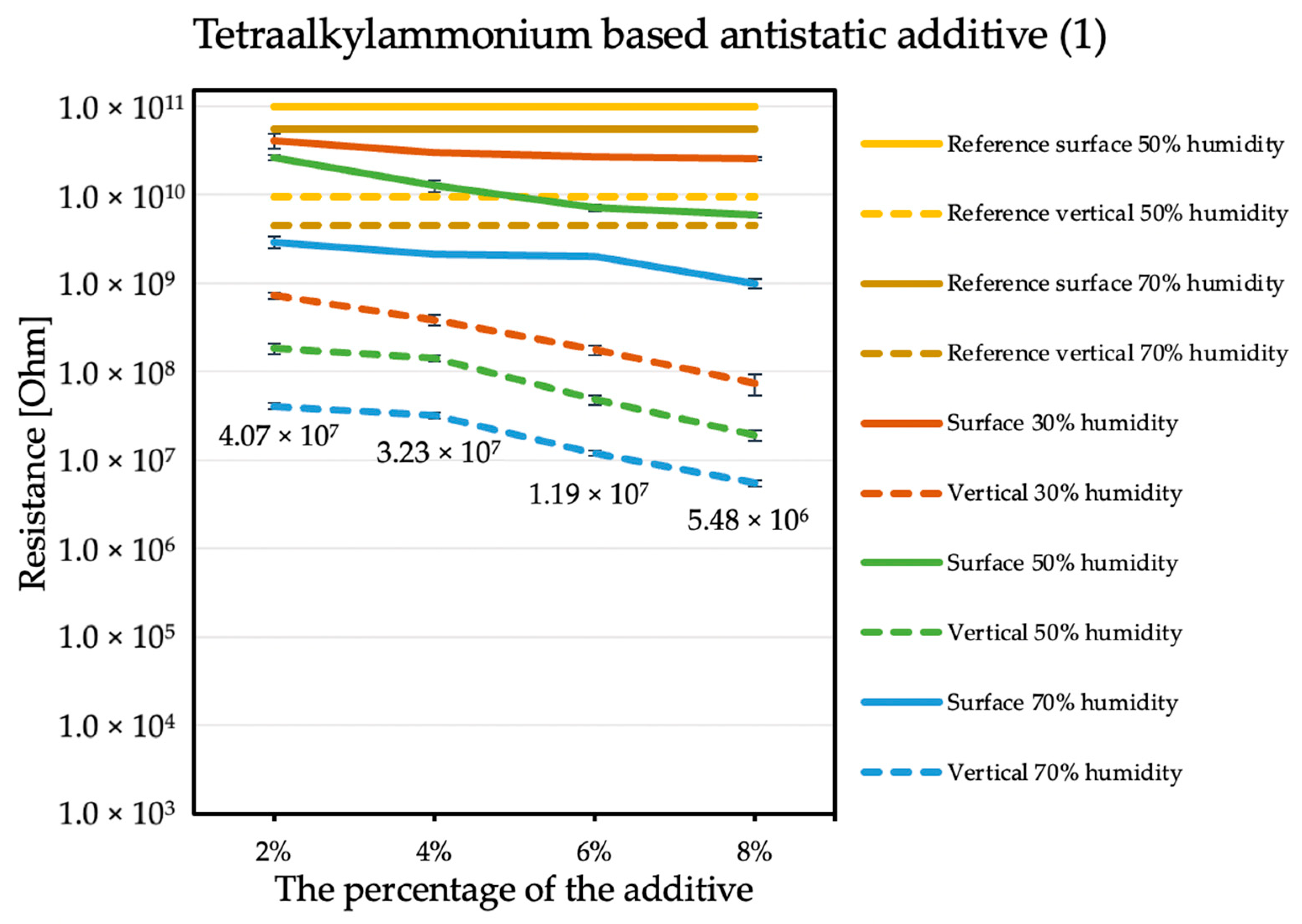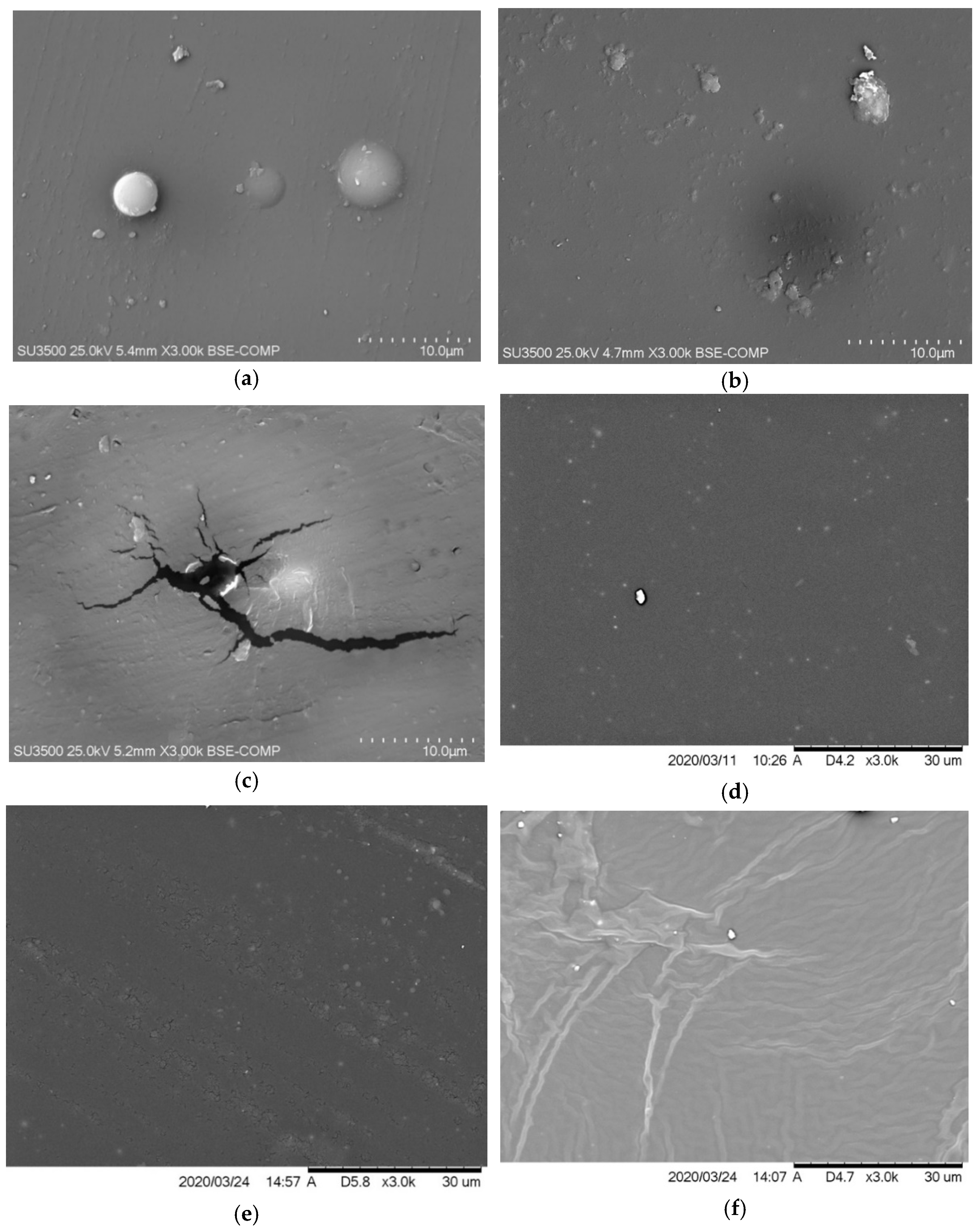New Hybrid Polyurea-Polyurethane Elastomers with Antistatic Properties and an Influence of Various Additives on Their Physicochemical Properties
Abstract
:1. Introduction
- Conductive floor with vertical and/or electrical leakage resistance lower than 105 Ω provides full anti-electrostatic protection in all conditions but does not provide protection against electric shock.
- Floor dissipating electrostatic charge with a vertical and/or leakage resistance greater than 105 Ω but less than 108 Ω provides anti-electrostatic protection in all cases, except for processes and technological operations with high dynamics or with materials with high ignition capacity. Such a floor also guarantees adequate protection against electric shock.
- Insulating floor with vertical and/or leakage resistance greater than or equal to 108 Ω does not guarantee anti-electrostatic protection but provides protection against electric shock.
2. Results and Discussion
2.1. Electrical Resistance
2.2. Fourier Transform Infrared Spectroscopy (FT-IR)
2.3. Tensile Tests
2.4. Scanning Electron Microscopy (SEM)
3. Materials and Methods
3.1. Samples Preparation
3.2. Methods
3.2.1. Electrical Resistance
3.2.2. Fourier Transform Infrared Spectroscopy (FT-IR)
3.2.3. Tensile Tests
3.2.4. Scanning Electron Microscopy (SEM)
4. Conclusions
Author Contributions
Funding
Institutional Review Board Statement
Informed Consent Statement
Data Availability Statement
Acknowledgments
Conflicts of Interest
Sample Availability
References
- Banera, J.; Maj, M.; Ubysz, A. Powłoki polimocznikowe w budownictwie: Kompendium wiedzy projektanta, wykonawcy, inwestora i użytkownika; DTP: D-Cocept, Grupa MD: Poznań, Poland, 2017; pp. 18–31, 97–98. ISBN 978-83-941001-1-7. [Google Scholar]
- Tripathi, M.; Parthasarathy, S.; Roy, P.K. Spray Processable Polyurea Formulations: Effect of Chain Extender Length on Material Properties of Polyurea Coatings. J. Appl. Polym. Sci. 2020, 137, 48573. [Google Scholar] [CrossRef]
- Bertleff, W.; Broekaert, M.; Bruchertseifer, C.; Dietz, M.; Hiller, M.; Hohberg, I.; Karl, W.; Pusel, T.; Schroter, N.; Wuhrer, H. Polyurea in the Construction Industry and the Environment; Polyurea Development Association PDA: Darmstadt, Germany, 2009. [Google Scholar]
- Szafran, J.; Matusiak, A. Polyurea Coating Systems: Definition, Research, Applications; XXII LSCE –2016 Monograph from Scientific Seminar: Olsztyn, Poland, 2016. [Google Scholar]
- Almacoat Floor, TDS [Online]; Alma-Color: Gniew, Poland. Available online: https://almacolor.pl/uploads/media/default/0001/01/45166e0114b280559299961b02f3bc9ca077445f.pdf (accessed on 21 April 2021).
- Whitechem 1045 TDS [Online]; Akdemir Group, Whitechem. Available online: http://www.whitechem.com.tr/_img/upload/WHITECHEM-POLYUREA-1045-EN.pdf (accessed on 21 April 2021).
- MasterSeal M 689, TDS [Online]; Master Builders Solutions Deutschland GmbH: Oldenburg, Germany. Available online: Https://Assets.Master-Builders-Solutions.Com/Pl-Pl/Tds%20mbs%20pl%20masterseal%20m%20689.Pdf (accessed on 21 April 2021).
- International Electrotechnical Commission; IEC/TS 60079-32-1:2013. Explosive Atmospheres: Electrostatic Hazards, Guidance; British Standards Institution: London, UK, 2013. [Google Scholar]
- ESD Solutions, [Online]; Gerflor Group. Available online: https://www.gerflor.com/media/virtual-library/old-ranges/old-gerflor-guide-esd-solutions-gb-old-range.pdf (accessed on 26 August 2021).
- Flowshield ESD Dissipative, SDS [Online]; Flowcrete Middle East FZCO, Dubai, United Arab Emirates. Available online: https://Www.Flowcrete.Ae/Media/6378/Flowshield-Esd-Dissipative-Tds.Pdf (accessed on 27 August 2021).
- MasterTop® BC 372AS, TDS [Online]; Master Builders Solutions Construction Chemicals LLC, Dubai, United Arab Emirates. Available online: Https://Assets.Master-Builders-Solutions.Com/En-Mne/Mastertop-Bc-372as-Tds.Pdf (accessed on 27 August 2021).
- EPITAN 60 Antistatic Epoxy Tank Coating TDS [Online]; Teknos, Helsinki, Finland. Available online: https://www.teknos.com/document/tds/en_71050-00_2.pdf (accessed on 27 August 2021).
- Dashore Anti-Static Epoxy Flooring - Methods and Applications. Available online: https://theconstructor.org/building/anti-static-epoxy-flooring-method-applications/14087/ (accessed on 10 April 2021).
- Weng, C.-J.; Chen, Y.-L.; Jhuo, Y.-S.; Yi-Li, L.; Yeh, J.-M. Advanced Antistatic/Anticorrosion Coatings Prepared from Polystyrene Composites Incorporating Dodecylbenzenesulfonic Acid-Doped SiO 2 @polyaniline Core-Shell Microspheres: Advanced Antistatic/Anticorrosion Coatings. Polym. Int. 2013, 62, 774–782. [Google Scholar] [CrossRef]
- He, H.; Yan, Y.; Qiu, Z.; Tan, X. A Novel Antistatic Polyurethane Hybrid Based on Nanoscale Ionic Material. Progress in Organic Coatings 2017, 113, 110–116. [Google Scholar] [CrossRef]
- Ceramic Polymer GmbH. Antistatic Internal Coating of Diesel Storage Tank as Well as Long-Term Corrosion Protection for Roof Construction; Ceramic Polymer GmbH: Rödinghausen, Germany, 2014. [Google Scholar]
- European Solvents Industry Group. Flammability: A Safety Guide for Users. 2013. Available online: https://www.esig.org/wp-content/uploads/2018/03/170914_BPG_Flammability_Final-002.pdf (accessed on 26 August 2021).
- Wang, J.; Zhang, C.; Du, Z.; Li, H.; Zou, W. Functionalization of MWCNTs with Silver Nanoparticles Decorated Polypyrrole and Their Application in Antistatic and Thermal Conductive Epoxy Matrix Nanocomposite. RSC Adv. 2016, 6, 31782–31789. [Google Scholar] [CrossRef]
- He, P. Application and Prospects of High-Strength Lightweight Materials Used in Coal Mine. IOP Conf. Ser. Mater. Sci. Eng. 2017, 230, 012003. [Google Scholar] [CrossRef] [Green Version]
- Song, H.; Liu, C.; Xue, F.; Wen, X.; Cheng, F. Experimental Study on Coal Fly Ash-Based Gas-Sealing Coating Used for Coal Mine Roadway Walls. Coatings 2020, 10, 863. [Google Scholar] [CrossRef]
- Ohsawa, A. Statistical Analysis of Fires and Explosions Attributed to Static Electricity over the Last 50 Years in Japanese Industry. J. Phys. Conf. Ser. 2011, 301, 012033. [Google Scholar] [CrossRef]
- Slovak Society of Chemical Engineering; International Conference; Kosiński, S.; Gonsior, M.; Rykowska, I.; Slovak University of Technology; Institute of Chemical and Environmental Engineering. Proceedings of the 47th International Conference of the Slovak Society of Chemical Engineering Proceedings: Online Conference, Bratislava, Slovakia, 18–19 May 2021.
- ESD Flooring-Definition, Types, Applications, Antistatic Resistance Standard & Best Options. Available online: https://www.accessfloorstore.com/news/228--esd-flooring-definition-types-applications-antistatic-resistance-standard--best-options. (accessed on 13 May 2021).
- Pernak, J.; Rzemienicki, T.; Materna, K. O Cieczach Jonowych “w Pigułce” (Historia, Właściwości i Rozwój). Chemik 2016, 70, 471–480. [Google Scholar]
- Pernak, J.; Czepukowicz, A.; Poźniak, R. New Ionic Liquids and Their Antielectrostatic Properties. Ind. Eng. Chem. Res. 2001, 40, 2379–2383. [Google Scholar] [CrossRef]
- Tsurumaki, A.; Tajima, S.; Iwata, T.; Scrosati, B.; Ohno, H. Antistatic Effects of Ionic Liquids for Polyether-Based Polyurethanes. Electrochim. Acta 2015, 175, 13–17. [Google Scholar] [CrossRef]
- Tsurumaki, A.; Tajima, S.; Iwata, T.; Scrosati, B.; Ohno, H. Evaluation of Ionic Liquids as Novel Antistatic Agents for Polymethacrylates. Electrochim. Acta 2017, 248, 556–561. [Google Scholar] [CrossRef]
- Tsurumaki, A.; Iwata, T.; Tokuda, M.; Minami, H.; Navarra, M.A.; Ohno, H. Polymerized Ionic Liquids as Durable Antistatic Agents for Polyether-Based Polyurethanes. Electrochim. Acta 2019, 308, 115–120. [Google Scholar] [CrossRef]
- He, D.; Liu, Z.; Huang, L. Progress in Ionic Liquids as Reaction Media, Monomers and Additives in High-Performance Polymers, Solvents, Ionic Liquids and Solvent Effects; Glossman-Mitnik, D., Maciejewska, M., Eds.; IntechOpen: London, UK, 2019; Available online: https://www.intechopen.com/chapters/67532 (accessed on 17 September 2021). [CrossRef] [Green Version]
- Bishnoi, A.; Kumar, S.; Rai, S.; Mishra, A. Applications of Ionic Liquids in Polymeric Composites. In Advanced Polymeric Materials for Sustainability and Innovations; Thottathil, S., Thomas, S., Kalarikkal, N., Rouxel, D., Eds.; Apple Academic Press: Oakville, Canada; Waretown, NJ, USA, 2018; pp. 29–48. ISBN 978-1-315-10243-6. [Google Scholar] [CrossRef]
- Stoppa, A.; Zech, O.; Kunz, W.; Buchner, R. The Conductivity of Imidazolium-Based Ionic Liquids from (−35 to 195) °C. A. Variation of Cation’s Alkyl Chain. J. Chem. Eng. Data 2010, 55, 1768–1773. [Google Scholar] [CrossRef]
- Rahman, M.B.A.; Jumbri, K.; Basri, M.; Abdulmalek, E.; Sirat, K.; Salleh, A.B. Synthesis and Physico-Chemical Properties of New Tetraethylammonium-Based Amino Acid Chiral Ionic Liquids. Molecules 2010, 15, 2388–2397. [Google Scholar] [CrossRef] [PubMed]
- Titus, D.; James Jebaseelan Samuel, E.; Roopan, S.M. Nanoparticle characterization techniques. In Green Synthesis, Characterization and Applications of Nanoparticles; Elsevier: Amsterdam, Netherlands; Kidlington, UK; Cambridge, MA, USA, 2019; pp. 303–319. ISBN 978-0-08-102579-6. [Google Scholar]
- Williams, D.H.; Fleming, I. Infrared Spectra. In Spectroscopic methods in organic chemistry; McGraw-Hill: London, UK; New York, NY, USA, 1995; pp. 28–62. ISBN 978-0-07-709147-7. [Google Scholar]
- Silverstein, R.M.; Webster, F.X.; Kiemle, D.J. Infrared Spectrometry. In Spectrometric identification of organic compounds; John Wiley & Sons: Hoboken, NJ, USA, 2005; pp. 72–126. ISBN 978-0-471-39362-7. [Google Scholar]
- Arunkumar, T.; Ramachandran, S. Surface Coating and Characterisation of Polyurea for Liquid Storage. Int. J. Ambient. Energy 2017, 38, 781–787. [Google Scholar] [CrossRef]
- Wang, S.-K.; Sung, C.S.P. Fluorescence and IR Characterization of Cure in Polyurea, Polyurethane, and Polyurethane−Urea. Macromolecules 2002, 35, 883–888. [Google Scholar] [CrossRef]
- Youssef, G.; Whitten, I. Dynamic Properties of Ultraviolet-Exposed Polyurea. Mech Time-Depend Mater 2017, 21, 351–363. [Google Scholar] [CrossRef]
- Nyquist, R.A. Phosphorus Compounds. In Interpreting infrared, Raman, and nuclear magnetic resonance spectra; Academic Press: San Diego, CA, USA, 2001; pp. 233–236. ISBN 978-0-12-523475-7. [Google Scholar]
- Logacheva, N.M.; Baulin, V.E.; Tsivadze, A.Y.; Pyatova, E.N.; Ivanova, I.S.; Velikodny, Y.A.; Chernyshev, V.V. Supporting information to the paper: Ni(II), Co(II), Cu(II), Zn(II) and Na(I) Complexes of a Hybrid Ligand 4′-(4‴-Benzo-15-Crown-5)-Methyloxy-2,2′:6′,2″-Terpyridine; IR-Spectra, Additional Views of the Structures, Figures Ofpowder Patterns for 1–5. Dalton Trans. 2009, 14, 2482–2489. [Google Scholar] [CrossRef]
- Davies, M.; Jones, W.J. The Infra-Red Spectrum and Structure of Cyanamide and Dimethylcyanamide. Trans. Faraday Soc. 1958, 54, 1454–1463. [Google Scholar] [CrossRef]
- Peñalber, C.Y.; Grenoble, Z.; Baker, G.A.; Baldelli, S. Surface Characterization of Imidazolium-Based Ionic Liquids with Cyano-Functionalized Anions at the Gas–Liquid Interface Using Sum Frequency Generation Spectroscopy. Phys. Chem. Chem. Phys. 2012, 14, 5122. [Google Scholar] [CrossRef]
- Delebecq, E.; Pascault, J.-P.; Boutevin, B.; Ganachaud, F. On the Versatility of Urethane/Urea Bonds: Reversibility, Blocked Isocyanate, and Non-Isocyanate Polyurethane. Chem. Rev. 2013, 113, 80–118. [Google Scholar] [CrossRef] [PubMed]
- Zhang, H.; Dun, Y.; Tang, Y.; Zuo, Y.; Zhao, X. Correlation between Natural Exposure and Artificial Ageing Test for Typical Marine Coating Systems. J. Appl. Polym. Sci. 2016, 133, 43893. [Google Scholar] [CrossRef]
- Che, K.; Lyu, P.; Wan, F.; Ma, M. Investigations on Aging Behavior and Mechanism of Polyurea Coating in Marine Atmosphere. Materials 2019, 12, 3636. [Google Scholar] [CrossRef] [PubMed] [Green Version]
- Polski Komitet Normalizacyjny. PN-EN 1081:2001 Elastyczne Pokrycia Podłogowe—Wyznaczanie Rezystancji Elektrycznej; Polski Komitet Normalizacyjny: Warszawa, Poland, 2001. [Google Scholar]
- International Organization for Standardization. ISO 527-2 Plastics—Determination of Tensile Properties—Part 2: Test Conditions for Moulding and Extrusion Plastics; International Organization for Standardization: Geneva, Switzerland, 2012. [Google Scholar]













Publisher’s Note: MDPI stays neutral with regard to jurisdictional claims in published maps and institutional affiliations. |
© 2021 by the authors. Licensee MDPI, Basel, Switzerland. This article is an open access article distributed under the terms and conditions of the Creative Commons Attribution (CC BY) license (https://creativecommons.org/licenses/by/4.0/).
Share and Cite
Kosiński, S.; Gonsior, M.; Krzyżanowski, P.; Rykowska, I. New Hybrid Polyurea-Polyurethane Elastomers with Antistatic Properties and an Influence of Various Additives on Their Physicochemical Properties. Molecules 2021, 26, 5778. https://doi.org/10.3390/molecules26195778
Kosiński S, Gonsior M, Krzyżanowski P, Rykowska I. New Hybrid Polyurea-Polyurethane Elastomers with Antistatic Properties and an Influence of Various Additives on Their Physicochemical Properties. Molecules. 2021; 26(19):5778. https://doi.org/10.3390/molecules26195778
Chicago/Turabian StyleKosiński, Szymon, Marcin Gonsior, Piotr Krzyżanowski, and Iwona Rykowska. 2021. "New Hybrid Polyurea-Polyurethane Elastomers with Antistatic Properties and an Influence of Various Additives on Their Physicochemical Properties" Molecules 26, no. 19: 5778. https://doi.org/10.3390/molecules26195778
APA StyleKosiński, S., Gonsior, M., Krzyżanowski, P., & Rykowska, I. (2021). New Hybrid Polyurea-Polyurethane Elastomers with Antistatic Properties and an Influence of Various Additives on Their Physicochemical Properties. Molecules, 26(19), 5778. https://doi.org/10.3390/molecules26195778





